Creating an herb garden that fits your style
Herb gardens can be grown anywhere! Learn different ways to lay out an herb garden—from container herb gardens to formal herb gardens. If you’re looking for ideas to fit more herbs into your garden, you’ve come to the right place!
Herbs are very versatile. Grow them among vegetables, in a flowerbed, on the patio, or in a dedicated herb garden. Most herbs will attract beneficial bugs like bees that will help pollinate vegetables and fruits.
Of course, herbs bring a meal to life! You only need a few sprigs of rosemary or basil leaves to contribute bags of flavor and turn the ordinary… into the extraordinary.
Planning an Herb Garden
When designing with herbs the first thing to consider after growing requirements (full sun!) is growth habit.
- Tall, statuesque herbs like angelica contribute vertical interest to the garden. They are generally planted towards the back of a bed so they don’t overshadow shorter plants but can also look great thrusting skywards among lower growing plants.
- Medium-sized herbs (from about one to three foot in height) will form the bulk of your planting. Combine a variety of leaf shapes, colors and textures to break up blocks of planting. And, of course, most herbs will also draw in numerous beneficial bugs, most noticeably bees that will go on to help pollinate vegetables and fruits.
- Lower-growing herbs like parsley or chives should be planted at the front of any scheme where they can form a neat edging or spill outwards.
Edging and Paving
Herbs for edging look simply stunning. Grown alongside a path they’ll release their aroma every time you brush past.
Creeping herbs like thyme, oregano and prostrate forms of rosemary are great for growing within paving, planted into cracks, opportunistically at the edges, between slabs or in other gaps. From here they’ll extend out to soften hard surfaces, while taking advantage of the radiated heat to waft their delicious fragrance even further.
These types of herbs work well bursting out from any landscaped surface to create a more relaxed, informal feel. Or try planting them en masse to form a practical, yet highly attractive living mulch that also works to crowd out weeds.
Formal Herb Garden
Or, how about a dedicated all-herb garden? A more formal herb garden made up of raised beds uses straight lines and patterns for symmetry. Raised beds especially lend themselves to this type of setup, helping create a sense of ordered calm. Planting one type of herb per bed emphasizes the order, while making maintenance far simpler.
Formal designs can be created on the smallest scale. For example, try creating a simple herb wheel, with one type of herb between each ‘spoke’ of the wheel. Select herbs that enjoy the same growing conditions to make maintenance easier.
Container Herb Garden
Many gardeners can only afford space for a few pots of herbs. But that doesn’t mean you can’t design an effortlessly stylish herbal heaven! Cluster pots of herbs, salads and vegetables together to create a living tapestry of leafy loveliness.
- Space rosemary pots across your terrace to create more of a feature.
- Or, mix them up in stone or metal troughs and herb towers to really pack your herbs in, while ensuring an eye-catching centerpiece to feed both body and soul.
- Herbs can also be used to offer vertical interest by growing them in containers held up on posts, or secured onto walls and fences.

Image: Herb garden designed with the Almanac Garden Planner
Design Your Ideal Herb Garden
Designing your own herb garden is hugely satisfying, and our Garden Planner makes it easy. Play around with different layouts at your leisure.
- Drop in any number of containers, planters, troughs or raised beds from the Selection Bar, or design your own beds using the drawing tools. Once you’re done, select Herbs from the selection bar drop-down menu and begin planting.
- If you’re unsure which herbs are best for your garden, click on the information buttons for handy growing advice, plus details on how each herb may be used. You can also use the Custom Filter button to narrow down the selection to show, for example, only easy-to-grow plants, or plants that will grow in partial shade.
- Have fun trying out a few designs and perfecting a herb garden that’s unique to you.
ADVERTISEMENT







